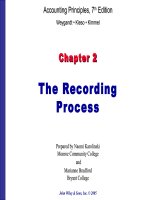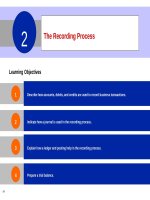Intermediate accounting volum 1 IFRS edition chapter 02
Bạn đang xem bản rút gọn của tài liệu. Xem và tải ngay bản đầy đủ của tài liệu tại đây (726.86 KB, 32 trang )
Chapter
2-1
CHAPTER
2
CONCEPTUAL FRAMEWORK FOR
FINANCIAL REPORTING
Intermediate Accounting
IFRS Edition
Kieso, Weygandt, and Warfield
Chapter
2-2
Learning
Learning Objectives
Objectives
1.
Describe the usefulness of a conceptual framework.
2.
Describe efforts to construct a conceptual framework.
3.
Understand the objective of financial reporting.
4.
Identify the qualitative characteristics of accounting information
.
5.
Define the basic elements of financial statements.
6.
Describe the basic assumptions of accounting.
7.
Explain the application of the basic principles of accounting.
8.
Describe the impact that constraints have on reporting accounti
ng information.
Chapter
2-3
Conceptual
Conceptual Framework
Framework For
For Financial
Financial Reporting
Reporting
Conceptual
Framework
Need
Development
Overview
First Level: Basic
Objective
Second Level:
Fundamental
Concepts
Qualitative
characteristics
Basic elements
Third Level:
Recognition,
Measurement, and
Disclosure
Concepts
Basic assumptions
Basic principles
Constraints
Summary of the
structure
Chapter
2-4
Conceptual
Conceptual Framework
Framework
Conceptual Framework establishes the concepts
that underlie financial reporting.
Need for a Conceptual Framework
Rule-making should build on and relate to an
established body of concepts.
Enables IASB to issue more useful and consistent
pronouncements over time.
Chapter
2-5
LO 1 Describe the usefulness of a conceptual framework.
Conceptual
Conceptual Framework
Framework
Development of a Conceptual Framework
IASB and FASB are working on a joint project to
develop a common conceptual framework
Framework will build on existing IASB and FASB
frameworks.
Project has identified the objective of financial
reporting (Chapter 1) and the qualitative
characteristics of decision-useful financial reporting
information.
Chapter
2-6
LO 2 Describe efforts to construct a conceptual framework.
Conceptual
Conceptual Framework
Framework
Overview of the Conceptual Framework
Three levels:
First Level = Basic objective
Second Level = Qualitative characteristics and
elements of financial statements
Third Level = Recognition, measurement, and
disclosure concepts
Chapter
2-7
LO 2 Describe efforts to construct a conceptual framework.
ASSUMPTIONS
PRINCIPLES
CONSTRAINTS
1. Economic entity
1. Measurement
1. Cost
2. Going concern
2. Revenue recognition
2. Materiality
3. Monetary unit
3. Expense recognition
4. Periodicity
4. Full disclosure
Third
level
5. Accrual
QUALITATIVE
CHARACTERISTICS
1. Fundamental
qualities
2. Enhancing
qualities
Illustration 2-7
Framework for Financial
Reporting
Chapter
2-8
ELEMENTS
1.
2.
3.
4.
5.
Assets
Liabilities
Equity
Income
Expenses
OBJECTIVE
Provide information
about the reporting
entity that is useful
to present and potential
equity investors,
lenders, and other
creditors in their
capacity as capital
Providers.
Second level
First level
LO 2 Describe efforts to construct
a conceptual framework.
First
First Level:
Level: Basic
Basic Objective
Objective
OBJECTIVE
“To provide financial information about the reporting entity
that is useful to present and potential equity investors,
lenders, and other creditors in making decisions in their
capacity as capital providers.”
Chapter
2-9
Provided by issuing general-purpose financial statements.
Assumption is that users have reasonable knowledge of business
and financial accounting matters to understand the information.
LO 3 Understand the objectives of financial reporting.
Second
Second Level:
Level: Fundamental
Fundamental Concepts
Concepts
Qualitative Characteristics of Accounting
Information
IASB identified the Qualitative Characteristics of
accounting information that distinguish better (more
useful) information from inferior (less useful)
information for decision-making purposes.
Chapter
2-10
LO 4 Identify the qualitative characteristics of accounting information.
Second
Second Level:
Level: Fundamental
Fundamental Concepts
Concepts
Illustration 2-2
Hierarchy of Accounting
Qualities
Chapter
2-11
LO 4 Identify the qualitative characteristics of accounting information.
Second
Second Level:
Level: Fundamental
Fundamental Concepts
Concepts
Fundamental Quality - Relevance
Relevance is one of the two fundamental qualities that make
accounting information useful for decision-making.
Chapter
2-12
LO 4 Identify the qualitative characteristics of accounting information.
Second
Second Level:
Level: Fundamental
Fundamental Concepts
Concepts
Fundamental Quality – Faithful Representation
Faithful representation means that the numbers and
descriptions match what really existed or happened.
Chapter
2-13
LO 4 Identify the qualitative characteristics of accounting information.
Second
Second Level:
Level: Fundamental
Fundamental Concepts
Concepts
Enhancing Qualities
Distinguish more-useful information from less-useful
information.
Chapter
2-14
LO 4 Identify the qualitative characteristics of accounting information.
ASSUMPTIONS
PRINCIPLES
CONSTRAINTS
1. Economic entity
1. Measurement
1. Cost
2. Going concern
2. Revenue recognition
2. Materiality
3. Monetary unit
4. Periodicity
Third
level
Basic
Elements
Basic
Elements
4. Full disclosure
3. Expense recognition
5. Accrual
QUALITATIVE
CHARACTERISTICS
1. Fundamental
qualities
2. Enhancing
qualities
Illustration 2-7
Framework for Financial
Reporting
Chapter
2-15
ELEMENTS
1.
2.
3.
4.
5.
Assets
Liabilities
Equity
Income
Expenses
OBJECTIVE
Provide information
about the reporting
entity that is useful
to present and potential
equity investors,
lenders, and other
creditors in their
capacity as capital
Providers.
Second level
First level
LO 4
Second
Second Level:
Level: Basic
Basic Elements
Elements
Chapter
2-16
LO 5 Define the basic elements of financial statements.
Second
Second Level:
Level: Basic
Basic Elements
Elements
Exercise 2-4: Identify the qualitative characteristic(s) to be used
given the information provided.
Characteristics
(a)
(b)
(c)
(d)
Chapter
2-17
Qualitative characteristic being
employed when companies in the
same industry are using the same
accounting principles.
Relevance
Quality of information that confirms
users’ earlier expectations.
Neutrality
Imperative for providing comparisons
of a company from period to period.
Timeliness
Ignores the economic consequences
of a standard or rule.
Understandability
Faithful representation
Predictive value
Confirmatory value
Completeness
Verifiability
Comparability
LO 5
Second
Second Level:
Level: Basic
Basic Elements
Elements
Exercise 2-4: Identify the qualitative characteristic(s) to be used
given the information provided.
Characteristics
(e)
(f)
(g)
Requires a high degree of consensus
among individuals on a given
measurement.
Relevance
Predictive value is an ingredient of this
fundamental quality of information.
Confirmatory value
Qualitative characteristics that
enhance both relevance and faithful
representation.
Completeness
Faithful representation
Predictive value
Neutrality
Timeliness
Verifiability
Understandability
Chapter
2-18
Comparability
LO 5
Second
Second Level:
Level: Basic
Basic Elements
Elements
Exercise 2-4: Identify the qualitative characteristic(s) to be used
given the information provided.
Characteristics
(h)
(i)
(j)
Chapter
2-19
Neutrality and completeness are
ingredients of this fundamental quality
of accounting information.
Relevance
Two fundamental qualities that make
accounting information useful for
decision-making purposes.
Confirmatory value
Issuance of interim reports is an
example of what enhancing
ingredient?
Timeliness
Faithful representation
Predictive value
Neutrality
Completeness
Verifiability
Understandability
Comparability
LO 5
Third
Third Level:
Level: Recognition,
Recognition, Measurement,
Measurement, and
and
Disclosure
Disclosure Concepts
Concepts
These concepts explain how companies should recognize,
measure, and report financial elements and events.
Recognition, Measurement, and Disclosure Concepts
ASSUMPTIONS
PRINCIPLES
CONSTRAINTS
1. Economic entity
1. Measurement
1. Cost
2. Going concern
2. Revenue recognition
2. Materiality
3. Monetary unit
3. Expense recognition
4. Periodicity
4. Full disclosure
5. Accrual
Illustration 2-7
Framework for
Financial Reporting
Chapter
2-20
LO 6 Describe the basic assumptions of accounting.
Third
Third Level:
Level: Assumptions
Assumptions
Basic Assumptions
Economic Entity – company keeps its activity separate from
its owners and other business unit.
Going Concern - company to last long enough to fulfill
objectives and commitments.
Monetary Unit - money is the common denominator.
Periodicity - company can divide its economic activities into
time periods.
Accrual Basis of Accounting – transactions are recorded in
the periods in which the events occur.
Chapter
2-21
LO 6 Describe the basic assumptions of accounting.
Third
Third Level:
Level: Assumptions
Assumptions
E2-8: Identify which basic assumption of accounting is best
described in each item below.
(a) The economic activities of FedEx Corporation
(USA) are divided into 12-month periods for the
purpose of issuing annual reports.
Periodicity
(b) Total S.A. (FRA) does not adjust amounts in its
financial statements for the effects of inflation.
Monetary
Unit
(c) Barclays (GBR) reports current and non-current
classifications in its statement of financial
position.
Going Concern
(d) The economic activities of Tokai Rubber
Industries (JPN) and its subsidiaries are merged
for accounting and reporting purposes.
Economic
Entity
Chapter
2-22
LO 6 Describe the basic assumptions of accounting.
Third
Third Level:
Level: Principles
Principles
Principles
Measurement
Cost is generally thought to be a faithful representation of the
amount paid for a given item.
Fair value is “the amount for which an asset could be exchanged,
a liability settled, or an equity instrument granted could be
exchanged, between knowledgeable, willing parties in an arm’s
length transaction.”
IASB has taken the step of giving companies the option to use fair
value as the basis for measurement of financial assets and
financial liabilities.
Chapter
2-23
LO 7 Explain the application of the basic principles of accounting.
Third
Third Level:
Level: Principles
Principles
Revenue Recognition - revenue is to be recognized when it
is probable that future economic benefits will flow to the company
and reliable measurement of the amount of revenue is possible.
Illustration 2-3
Timing of Revenue Recognition
Chapter
2-24
LO 7 Explain the application of the basic principles of accounting.
Third
Third Level:
Level: Principles
Principles
Expense Recognition - outflows or “using up” of assets
or incurring of liabilities (or a combination of both) during a
period as a result of delivering or producing goods and/or
rendering services.
Illustration 2-4
Expense Recognition
“Let the expense follow the revenues.”
Chapter
2-25
LO 7 Explain the application of the basic principles of accounting.









